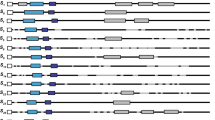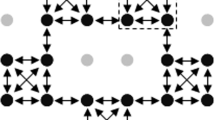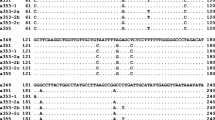Abstract
This study characterises a series of 12 S-locus haplotype-specific F-box protein genes (SFB) in cherry (Prunus avium) that are likely candidates for the pollen component of gametophytic self-incompatibility in this species. Primers were designed to amplify 12 SFB alleles, including the introns present in the 5′ untranslated region; sequences representing the S-alleles S 1 , S 2 , S 3 , S 4 , S 4 ′, S 5 , S 6 , S 7 , S 10 , S 12 , S 13 and S 16 were cloned and characterized. [The nucleotide sequences reported in this paper have been submitted to the EMBL/GenBank database under the following accession numbers: PaSFB 1 (AY805048), PaSFB 2 (AY805049), PaSFB 3 (AY805057), PaSFB 4 (AY649872), PaSFB 4 ′ (AY649873), PaSFB 5 (AY805050), PaSFB 6 (AY805051), PaSFB 7 (AY805052), PaSFB 10 (AY805053), PaSFB 12 (AY805054), PaSFB 13 (AY805055), PaSFB 16 (AY805056).] Though the coding regions of six of these alleles have been reported previously, the intron sequence has previously been reported only for S 6 . Analysis of the introns revealed sequence and length polymorphisms. A novel, PCR-based method to genotype cultivars and wild accessions was developed which combines fluorescently labelled primers amplifying the intron of SFB with similar primers for the first intron of S-RNase alleles. Intron length polymorphisms were then ascertained using a semi-automated sequencer. The convenience and reliability of this method for the determination of the self-incompatibility (SI) genotype was demonstrated both in sweet cherry cultivars representing alleles S 1 to S 16 and in individuals from a wild population encompassing S-alleles S 17 to S 22 . This method will greatly expedite SI characterisation in sweet cherry and also facilitate large-scale studies of self-incompatibility in wild cherry and other Prunus populations.





Similar content being viewed by others
Abbreviations
- GSI:
-
Gametophytic self-incompatibility
- SI:
-
Self-incompatibilty
- SFB :
-
S-locus F-box
- SLFL :
-
Non-haplotype-specific S-locus F-box
References
Anderson MA, Cornish EC, Mau SL, Williams EG, Hoggart R, Atkinson A, Bonig I, Grego B, Simpson R, Roche PJ, Haley JD, Penschow JD, Niall HD, Tregear GW, Coghlan JP, Crawford RJ, Clarke AE (1986) Cloning of cDNA for a stylar glycoprotein associated with expression of self-incompatibility in Nicotiana alata. Nature 321:38–44
Bošković R, Tobutt KR (1996) Correlation of stylar ribonuclease zymograms with incompatibility alleles in sweet cherry. Euphytica 90:245–250
Bošković R, Tobutt KR (2001) Genotyping cherry cultivars assigned to incompatibility groups, by analysing stylar ribonucleases. Theor Appl Genet 103:475–485
Cipriani G, Lot G, Huang WG, Marrazzo MT, Peterlunger E, Testolin R (1999) AC/GT and AG/CT microsatellite repeats in peach Prunus persica (L) Batsch: isolation, characterisation and cross-species amplification in Prunus. Theor Appl Genet 99:65–72
Crane MB, Brown AG (1937) Incompatibility and sterility in the sweet cherry, Prunus avium L. J Pomol Hortic Sci 15:86–116
Crane MB, Lawrence WJC (1929) Genetical and cytological aspects of incompatibility and sterility in cultivated fruits. J Pomol Hortic Sci 7:276–301
De Cuyper B, Sonneveld T, Tobutt KR (2005) Determining self-incompatibility genotypes in Belgian wild cherries. Mol Ecol 14:945–955
Downey SL, Iezzoni AF (2000) Polymorphic DNA markers in black cherry (Prunus serotina) are identified using sequences from sweet cherry, peach and sour cherry. J Am Soc Hortic Sci 125:76–80
Doyle JJ, Doyle JL (1987) A rapid DNA isolation procedure for small quantities of fresh leaf tissue. Phytochem Bull 19:11–15
Ducci F, Santi F (1998) The distribution of clones in managed and unmanaged populations of wild cherry (Prunus avium). Can J For Sci 27:1998–2004
Entani T, Iwano M, Shiba H, Che FS, Isogai A, Takayama S (2003) Comparative analysis of the self-incompatibility (S−) locus region of Prunus mume: identification of a pollen-expressed F-box gene with allelic diversity. Genes Cells 8:203–213
Felsenstein J (1985) Confidence limits on phylogenies: an approach using the bootstrap. Evolution 39:783–791
Franklin-Tong N, Franklin FCH (2003) Gametophytic self-incompatibility inhibits pollen tube growth using different mechanisms. Trends Plant Sci 8:598–605
Igic B, Kohn JR (2001) Evolutionary relationships among self-incompatibility RNases. Proc Natl Acad Sci USA 98:13167–13171
Ikeda K, Igic B, Ushijima K, Yamane H, Hauck NR, Nakano R, Sassa H, Iezzoni AF, Kohn JR, Tao R (2004) Primary structural features of the S haplotype-specific F-box protein, SFB, in Prunus. Sex Plant Reprod 16:235–243
Ishimizu T, Endo T, Yamaguchi-Kabata Y, Nakamura KT, Sakiyama F, Norioka S (1998) Identification of regions in which positive selection may operate in S-RNase of Rosaceae, implication for S-allele-specific recognition sites in S-RNase. FEBS Lett 440:337–342
Kato S, Mukai Y (2004) Allelic diversity of S-RNase at the self-incompatibility locus in natural flowering cherry populations (Prunus lannesiana var. speciosa). Heredity 92:249–256
Lai Z, Ma WS, Han B, Liang LZ, Zhang YS, Hong GF, Xue YB (2002) An F-box gene linked to the self-incompatibility (S) locus of Antirrhinum is expressed specifically in pollen and tapetum. Plant Mol Biol 50:29–42
Matthews P (1970) Genetics and exploitation of self-fertility in the sweet cherry. In: Proceedings of the Angers Fruit Breed Symposium, INRA,Versailles, pp 307–316
McClure BA, Haring V, Ebert PR, Anderson MA, Simpson RJ, Sakiyama F, Clarke AE (1989) Style self-incompatibility gene-products of Nicotiana alata are ribonucleases. Nature 342:955–957
McCubbin AG, Kao TH (2000) Molecular recognition and response in pollen and pistil interactions. Annu Rev Cell Dev Biol 16:333–364
de Nettancourt D (2001) Incompatibility and incongruity in wild and cultivated plants. Springer, Berlin Heidelberg New York
Qiao H, Wang F, Zhao L, Zhou JL, Lai Z, Zhang YS, Robbins TP, Xue YB (2004a) The F-Box protein AhSLF-S-2 controls the pollen function of S-RNase-based self-incompatibility. Plant Cell 16:2307–2322
Qiao H, Wang HY, Zhao L, Zhou JL, Huang J, Zhang YS, Xue YB (2004b) The F-box protein AhSLF-S-2 physically interacts with S-RNases that may be inhibited by the ubiquitin/26S proteasome pathway of protein degradation during compatible pollination in Antirrhinum. Plant Cell 16:582–595
Romero C, Vilanova S, Burgos L, Martinez-Calvo J, Vicente M, Llacer G, Badenes ML (2004) Analysis of the S-locus structure in Prunus armeniaca L. Identification of S-haplotype specific S-RNase and F-box genes. Plant Mol Biol 56:145–157
Sassa H, Nishio T, Kowyama Y, Hirano H, Koba T, Ikehashi H (1996) Self incompatibility (S) alleles of the Rosaceae encode members of a distinct class of the T-2/S ribonuclease superfamily. Mol Gen Genet 250:547–557
Sijacic P, Wang X, Skirpan AL, Wang Y, Dowd PE, McCubbin AG, Huang S, Kao TH (2004) Identification of the pollen determinant of S-RNase-mediated self-incompatibility. Nature 429:302–305
Sonneveld T, Robbins TP, Boskovic R, Tobutt KR (2001) Cloning of six cherry self-incompatibility alleles and development of allele-specific PCR detection. Theor Appl Genet 102:1046–1055
Sonneveld T, Tobutt KR, Robbins TP (2003) Allele-specific PCR detection of sweet cherry self-incompatibility (S) alleles S1 to S16 using consensus and allele-specific primers. Theor Appl Genet 107:1059–1070
Sonneveld T, Tobutt KR, Vaughan SP, Robbins TP (2005a) Loss of pollen-S function in two self-compatible selections of Prunus avium is associated with deletion/mutation of an S-haplotype-specific F-box gene. Plant Cell 17:37–51
Sonneveld T, Robbins TP, Tobutt KR (2005b) Improved discrimination of self-incompatibility S-RNase alleles in cherry and high throughput genotyping by automated sizing of first intron PCR products. Plant Breed (in press)
Steinbachs JE, Holsinger KE (2002) S-RNase-mediated gametophytic self-incompatibility is ancestral in eudicots. Mol Biol Evol 19:825–829
Swofford DL (2003) PAUP* phylogenetic analysis using parsimony (* and other methods). Sinauer Associates, Sunderland
Tao R, Yamane H, Sugiura A, Murayama H, Sassa H, Mori H (1999) Molecular typing of S-alleles through identification, characterization and cDNA cloning for S-RNases in sweet cherry. J Am Soc Hortic Sci 124:224–233
Thompson JD, Gibson TJ, Plewniak F, Jeanmougin F, Higgins DG (1997) The CLUSTAL_X windows interface: flexible strategies for multiple sequence alignment aided by quality analysis tools. Nucleic Acids Res 25:4876–4882
Tobutt KR, Sonneveld T, Bekefi Z,Bošković R (2004) Cherry (in)compatibility genotypes—an updated cultivar table. Acta Hort 663:667–671
Ushijima K, Sassa H, Dandekar AM, Gradziel TM, Tao R, Hirano H (2003) Structural and transcriptional analysis of the self-incompatibility locus of almond: identification of a pollen-expressed F-box gene with haplotype-specific polymorphism. Plant Cell 15:771–781
Ushijima K, Yamane H, Watari A, Kakehi E, Ikeda K, Hauck NR, Iezzoni AF, Tao RT (2004) The S haplotype-specific F-box protein gene, SFB, is defective in self-compatible haplotypes of Prunus avium and P. mume. Plant J 39:573–586
Vaughan SP, Russell K (2004) Characterization of novel microsatellites and development of multiplex PCR for large-scale population studies in wild cherry, Prunus avium. Mol Ecol Notes 4:429–431
Wiersma PA, Wu Z, Zhou L, Hampson C, Kappel F (2001) Identification of new self-incompatibility alleles in sweet cherry (Prunus avium L.) and clarification of incompatibility groups by PCR and sequencing analysis. Theor Appl Genet 102:700–708
Xue YB, Carpenter R, Dickinson HG, Coen ES (1996) Origin of allelic diversity in Antirrhinum S locus RNases. Plant Cell 8:805–814
Yamane H, Ikeda K, Ushijima K, Sassa H, Tao R (2003a) A pollen-expressed gene for a novel protein with an F-box motif that is very tightly linked to a gene for S-RNase in two species of cherry, Prunus cerasus and P. avium. Plant Cell Physiol 44:764–769
Yamane H, Ushijima K, Sassa H, Tao R (2003b) The use of the S haplotype-specific F-box protein gene, SFB as a molecular marker for S-haplotypes and self-compatibility in Japanese apricot (Prunus mume). Theor Appl Genet 107:1357–1361
Acknowledgements
This research was supported by funding from Defra and the Forestry Commission (Grant no.WD0502). The authors would also like to thank Bart De Cuyper, Dr. Tineke Sonneveld and Dr. Radovan Bošković for provision of primers and P. avium material and for many helpful discussions.
Author information
Authors and Affiliations
Corresponding author
Additional information
Communicated by H. Nybom
Rights and permissions
About this article
Cite this article
Vaughan, S.P., Russell, K., Sargent, D.J. et al. Isolation of S-locus F-box alleles in Prunus avium and their application in a novel method to determine self-incompatibility genotype. Theor Appl Genet 112, 856–866 (2006). https://doi.org/10.1007/s00122-005-0187-9
Received:
Accepted:
Published:
Issue Date:
DOI: https://doi.org/10.1007/s00122-005-0187-9




